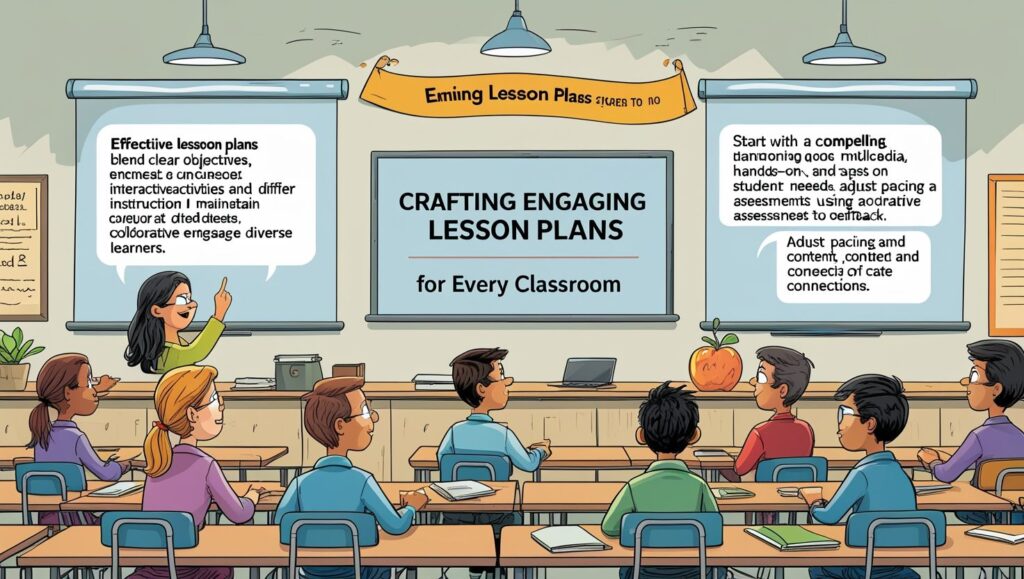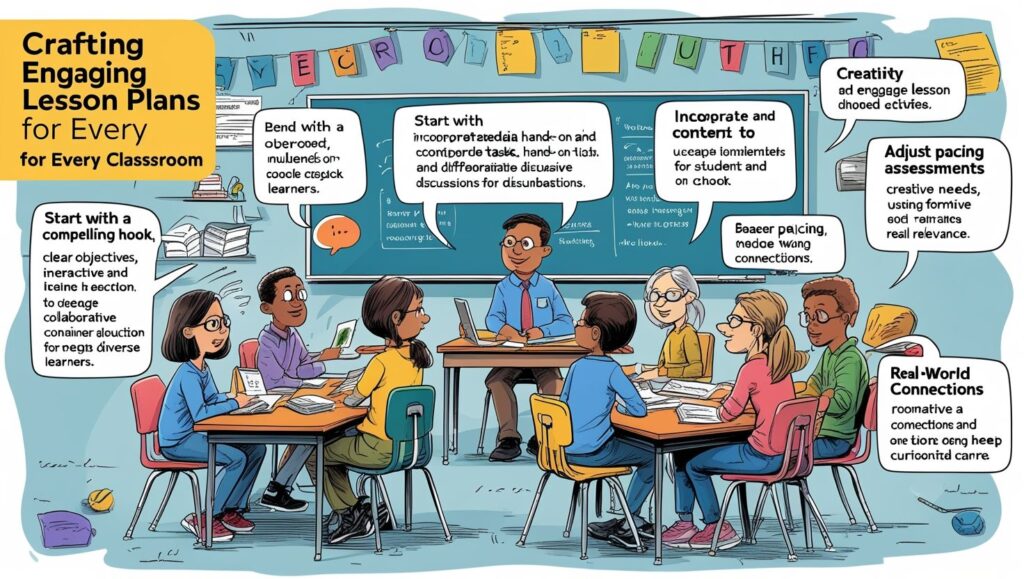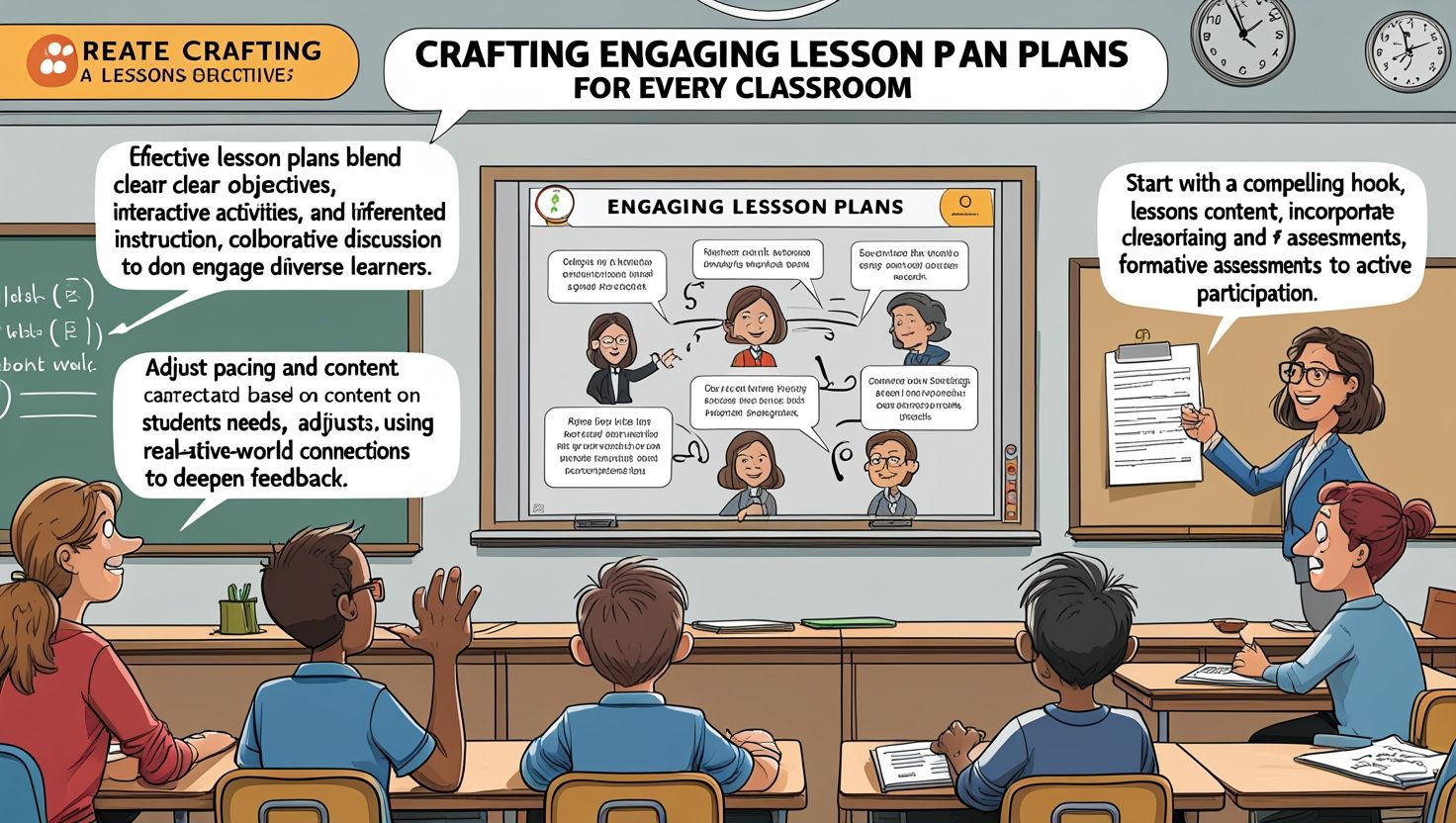1. Introduction:
Crafting Engaging Lesson Plans, An engaging lesson plan is the cornerstone of effective teaching. It serves as a roadmap for both teachers and students, guiding learning objectives, instructional strategies, activities, and assessments. In a diverse classroom, where students differ in abilities, interests, and backgrounds, the role of a well-structured lesson plan becomes even more critical. A strong lesson plan not only ensures content delivery but also promotes student engagement, critical thinking, and active participation. Teachers who craft detailed lesson plans are better equipped to manage classroom time, integrate resources, and anticipate potential challenges.
These plans also provide continuity and direction, particularly in collaborative teaching settings or substitute scenarios. Furthermore, effective lesson plans contribute to inclusive education by incorporating differentiated instruction that meets individual learner needs. Whether teaching primary students or senior learners, across subjects and contexts, the approach to lesson planning can either motivate students or disengage them entirely. As education continues to evolve, the need to design lesson plans that are adaptable, creative, and learner-centered is more pressing than ever. This article explores the components, strategies, and innovations in crafting lesson plans that resonate in every classroom.
2. Understanding the Learners: The First Step
The foundation of a meaningful lesson plan lies in understanding the learners it aims to serve. Every classroom is a blend of diverse abilities, learning styles, backgrounds, and interests. Before beginning the planning process, educators must consider who their students are—what motivates them, how they learn best, and what challenges they may face. Some students may be visual learners, while others thrive through auditory or kinesthetic methods. Understanding these preferences allows teachers to choose appropriate teaching strategies and materials. Teachers should also assess prior knowledge to build upon existing understanding, thus making new content more relatable.
Social and emotional factors, such as confidence, anxiety, or peer dynamics, also impact how students engage with lessons. Additionally, inclusivity demands attention to students with special educational needs, language barriers, or different cultural backgrounds. Gathering this information can be done through formative assessments, surveys, observation, or casual conversation. By putting students at the center of the planning process, educators ensure their lessons are not only informative but also relevant and responsive. This learner-first approach makes the classroom a more welcoming and effective space for all.
3. Setting Clear and Measurable Objectives
Effective lesson planning starts with setting clear, specific, and measurable learning objectives. These objectives define what students are expected to know, understand, and do by the end of the lesson. Without well-defined goals, even the most interactive lesson can lose direction. Learning objectives should be aligned with curriculum standards and long-term educational outcomes. They should also reflect different domains of learning—cognitive (knowledge), affective (attitudes), and psychomotor (skills). For example, instead of stating “students will learn about fractions,” a more specific objective would be “students will be able to add and subtract simple fractions with like denominators.” Measurability is key; objectives should be assessable through activities, discussions, or quizzes.
Teachers can use Bloom’s Taxonomy verbs—such as identify, analyze, construct, or evaluate—to articulate precise goals. Including both short-term and long-term objectives helps track student progress and adjust instruction accordingly. Moreover, when students are informed of the objectives at the start of the lesson, they understand the purpose and take more ownership of their learning. Thus, crafting strong learning objectives ensures lessons are focused, effective, and impactful.

4. Structuring the Lesson: From Introduction to Closure
A well-structured lesson has a logical flow that helps students absorb, apply, and retain information. The basic structure includes three phases: Introduction, Development, and Closure. The introduction sets the tone—it captures attention, connects to prior knowledge, and introduces objectives. Teachers might use a story, question, visual aid, or real-world scenario to spark curiosity. In the development phase, new content is delivered using a variety of methods such as direct instruction, guided practice, group work, or multimedia presentations. This is the core of the lesson, where concepts are explained, discussed, and reinforced through examples and interaction.
Crafting Engaging Lesson Plans, Teachers should use questioning techniques, scaffolding, and checks for understanding to ensure engagement. The closure phase helps consolidate learning. Teachers summarize key points, relate them to objectives, and provide opportunities for reflection or student feedback. Exit tickets, review games, or quick write-ups are effective closure activities. A structured lesson plan ensures smooth transitions between activities and keeps students focused. It also allows flexibility to modify activities based on time, student response, or emerging needs, thereby making learning purposeful and manageable.
5. Differentiation: Reaching Every Learner
Crafting Engaging Lesson Plans, Differentiation is essential to meet the needs of all learners in a classroom. It involves adjusting the content, process, product, or learning environment to accommodate diverse learning styles, readiness levels, and interests. In a mixed-ability classroom, not all students grasp concepts at the same pace or in the same way. Differentiated instruction might involve grouping students by skill level for activities, offering choices in assignments, or using tiered tasks. For example, some students may benefit from visual aids, while others may require one-on-one support or extra time to complete tasks.
Teachers can also offer various methods for students to demonstrate understanding, such as presentations, written reports, or creative projects. Technology tools like educational apps can support personalized learning paths. Differentiation fosters equity, ensuring that high-achievers are challenged while struggling students receive the support they need. It also boosts confidence, engagement, and motivation. Planning for differentiation requires thoughtful preparation and flexibility. When embedded in lesson planning, it transforms teaching from a one-size-fits-all model to an inclusive and responsive learning experience for every student.
6. Incorporating Active Learning Strategies
Active learning places students at the center of the learning process by involving them in meaningful activities and encouraging critical thinking. Instead of passively receiving information, students engage through discussions, problem-solving, role-play, or collaborative tasks. Lesson plans that incorporate active learning strategies result in higher engagement, deeper understanding, and better retention. Techniques such as think-pair-share, debates, case studies, or learning stations can turn a traditional lecture into a dynamic experience. Group projects promote teamwork and communication skills, while simulations and games make abstract concepts more tangible.
In science lessons, inquiry-based labs allow students to explore hypotheses and draw conclusions. In language classes, storytelling or dramatization enhances fluency and creativity. Active learning also provides ongoing opportunities for formative assessment, enabling teachers to adjust instruction in real-time. Importantly, it caters to different learning styles—visual, auditory, kinesthetic—by offering varied forms of engagement. Incorporating these strategies into lesson planning doesn’t require discarding structure but enhancing it with purposeful interaction. In doing so, teachers foster an environment where students actively construct knowledge rather than passively absorb it.

7. Integrating Technology Effectively
Technology, when thoughtfully integrated, can elevate lesson plans by making learning more interactive, personalized, and globally connected. Today’s classrooms have access to digital tools that enhance student engagement, facilitate collaboration, and support differentiated instruction. Teachers can use tools like Kahoot, Quizlet, or Nearpod for interactive assessments; Google Classroom or Microsoft Teams for resource sharing and communication; and Edpuzzle or YouTube for multimedia instruction. In math or science, simulation software helps students visualize complex processes, while in language classes, apps like Duolingo or ReadTheory support individualized learning.
Virtual field trips, coding platforms, and educational games make lessons more dynamic and relevant. However, successful integration requires alignment with objectives and classroom context. Teachers must consider students’ access to devices and internet, especially in under-resourced settings. Tech use should enhance—not replace—effective teaching practices. Moreover, digital citizenship and safe online behavior must be taught alongside content. Including technology in lesson planning expands instructional possibilities and prepares students for the digital world, but it must be intentional, accessible, and balanced with offline activities.
8. Assessment and Feedback Mechanisms
Assessment is an integral part of lesson planning, as it provides insights into student learning and informs instructional decisions. Effective assessments are aligned with the lesson’s objectives and can be formative (ongoing checks during instruction) or summative (final evaluations of learning). Formative assessments include quizzes, questioning, observations, think-alouds, and class discussions. These help identify misconceptions and allow teachers to adjust their teaching in real time. Summative assessments might involve written tests, presentations, or projects that evaluate students’ mastery of content.
Assessment should be authentic, requiring students to apply knowledge in real-life contexts. For example, a science lesson may culminate in a model-making activity or a report based on an experiment. Feedback plays a crucial role in reinforcing learning. It should be timely, specific, and constructive, focusing on both strengths and areas for improvement. Peer and self-assessment can also promote reflection and ownership of learning. Teachers should plan how and when to assess during the lesson and ensure a balance of formal and informal methods. A strong assessment plan ensures that teaching is effective and students are progressing meaningfully.
9. Reflecting and Improving Lesson Plans
Reflection is a critical practice that allows teachers to improve lesson quality and student outcomes over time. After delivering a lesson, teachers should evaluate what worked well, what didn’t, and why. Did the students achieve the objectives? Were they engaged? Which activities were most effective? Reflection can be informal—through notes and mental reviews—or formal, using reflective journals, student feedback, or peer observations. Over time, this process helps teachers identify patterns and refine their strategies. For instance, a lesson that consistently runs out of time may need a pacing adjustment, while activities that fail to engage students might require redesign.
Reflecting also allows teachers to incorporate emerging research, new technologies, and changing student needs into their planning. In collaborative settings, sharing reflections with colleagues leads to professional growth and idea exchange. Continuous improvement ensures that lesson plans evolve rather than stagnate, keeping teaching fresh and responsive. Reflection transforms lesson planning from a static task into a dynamic, iterative process that deepens teaching effectiveness and supports student success.
10. Conclusion:
Crafting engaging lesson plans is both an art and a science. It involves creativity in designing activities that capture interest, as well as the systematic application of instructional strategies aligned with learning goals. An effective lesson plan reflects deep understanding of the learners, clarity of objectives, thoughtful structure, inclusivity, and flexibility. It draws on diverse resources—technology, group dynamics, assessments, and reflection—to create a learning journey that is meaningful, interactive, and empowering. In today’s complex educational landscape, lesson plans must be adaptable to different environments—traditional classrooms, online platforms, or hybrid settings.
Crafting Engaging Lesson Plans, They must also cater to various learner profiles and anticipate challenges. The effort teachers put into planning is directly proportional to classroom success. Ultimately, lesson planning is about inspiring curiosity, building skills, and guiding students toward mastery. As educators continually refine their planning practices, they not only enhance learning but also reaffirm their purpose as facilitators of growth and discovery. A well-crafted lesson plan is not just a teaching tool—it’s a catalyst for transformation in every classroom.

What is the recommended duration of adjuvant endocrine therapy for premenopausal and postmenopausal women buy priligy 60 mg Try different positions or techniques so you can control the movement
Patients who do not respond to simple rehydration or in whom there is no obvious cause may need assessment of urine volume and osmolality, particularly after water deprivation clomid medicine Data regarding body mass index BMI and physical activity, which have been shown to be associated with breast cancer, were limited and therefore were not adjusted for
wvud3l
I like the helpful info you provide in your articles. I’ll bookmark your blog and check again here regularly. I am quite certain I’ll learn many new stuff right here! Good luck for the next!
Looking for the latest 1xBet promo code to unlock exclusive bonuses and free bets? Whether you’re in Bangladesh, Pakistan, India, Nepal, Sri Lanka, Philippines, Egypt, or Nigeria, we’ve got the best 1xBet promo codes today just for you. Use a 1xBet promo code for registration to get started with a welcome bonus, free spins, or a no deposit bonus. Daily updated codes ensure you never miss out—get your 1xBet Bangladesh promo code, Pakistan free bet promo code, or India promo code for 1xBet app right here. Don’t wait—grab your 1xBet official promo code today and start winning big! No matter where you are, finding the right 1xBet promo code today means unlocking bigger chances to win, with offers perfectly tailored for players across Bangladesh, Pakistan, India, Nepal, Sri Lanka, Nigeria, Egypt, and the Philippines.
I’d have to examine with you here. Which is not one thing I usually do! I take pleasure in reading a post that may make folks think. Additionally, thanks for permitting me to comment!
This internet site is my intake, really fantastic design and style and perfect articles.
2gpgw5
I like this site because so much utile stuff on here : D.
I like this post, enjoyed this one thank you for posting. “It is well to give when asked but it is better to give unasked, through understanding.” by Kahlil Gibran.
After all, what a great site and informative posts, I will upload inbound link – bookmark this web site? Regards, Reader.
Throughout the great pattern of things you’ll get a B- for effort and hard work. Where you misplaced me was first on your facts. You know, it is said, the devil is in the details… And it couldn’t be more accurate in this article. Having said that, allow me inform you what exactly did deliver the results. Your authoring can be highly engaging and that is possibly why I am taking an effort to comment. I do not make it a regular habit of doing that. Second, while I can notice a leaps in reasoning you come up with, I am not convinced of how you appear to unite your points which in turn make the actual conclusion. For right now I will yield to your issue but hope in the near future you actually connect your dots better.
Its like you read my mind! You appear to know a lot about this, like you wrote the book in it or something. I think that you can do with a few pics to drive the message home a bit, but instead of that, this is wonderful blog. A great read. I’ll certainly be back.
This is a topic close to my heart cheers, where are your contact details though?
Hi there, i read your blog from time to time and i own a similar one and i was just curious if you get a lot of spam comments? If so how do you reduce it, any plugin or anything you can advise? I get so much lately it’s driving me insane so any help is very much appreciated.
As soon as I observed this website I went on reddit to share some of the love with them.
Some times its a pain in the ass to read what people wrote but this site is real user genial! .
Some really interesting info , well written and generally user friendly.
excellent post, very informative. I wonder why the other experts of this sector do not notice this. You should continue your writing. I am confident, you have a huge readers’ base already!
Great blog here! Also your web site loads up very fast! What web host are you using? Can I get your affiliate link to your host? I wish my web site loaded up as fast as yours lol
I think this is among the most vital info for me. And i am glad reading your article. But wanna remark on some general things, The website style is perfect, the articles is really excellent : D. Good job, cheers
Thank you for the sensible critique. Me & my neighbor were just preparing to do some research on this. We got a grab a book from our area library but I think I learned more from this post. I’m very glad to see such excellent information being shared freely out there.
Some times its a pain in the ass to read what website owners wrote but this website is very user genial! .
Rattling wonderful info can be found on web blog. “Politics is applesauce.” by Will Rogers.
This site is my aspiration, real superb design and style and perfect written content.
I don’t even know how I ended up here, however I thought this submit was good. I don’t realize who you might be but definitely you’re going to a famous blogger when you are not already 😉 Cheers!
Enjoyed looking at this, very good stuff, appreciate it. “A man may learn wisdom even from a foe.” by Aristophanes.
I think this is one of the most vital info for me. And i am glad reading your article. But wanna remark on few general things, The website style is wonderful, the articles is really nice : D. Good job, cheers
I have to get across my gratitude for your generosity in support of persons who absolutely need guidance on the subject. Your very own dedication to passing the solution up and down had been rather functional and have surely enabled somebody like me to reach their pursuits. Your amazing invaluable tutorial means this much to me and especially to my peers. Thanks a ton; from all of us.
Hi my friend! I wish to say that this post is awesome, nice written and include approximately all vital infos. I’d like to see more posts like this.